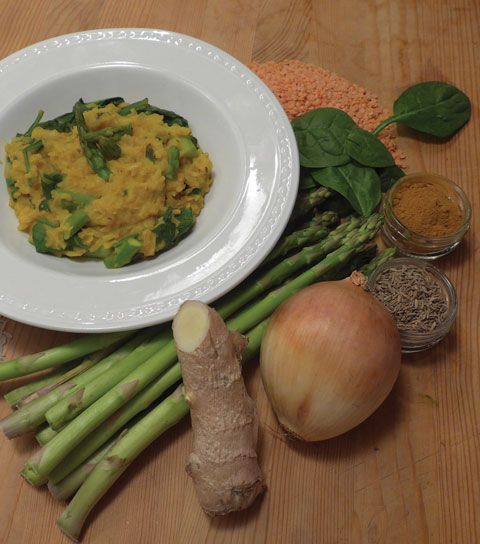
What comes to mind when you hear the word cleanse? A fast, kale juice for a week, or The Master Cleanse? Many cleanses these days ask that you move away from solid food and drink something consistently for a period of time. By taking away anything difficult to digest, the body reserves energy from over working hard to break down foods and makes room for any toxins to leave the body.
Spring cleaning: Remove clutter not only from your apartment but from your body as well. As the air starts to warm up and the days get continuously longer, this is an ideal time to rid the body of any residual winter toxins.
But let’s shift our perspective: Instead of taking things away, how can we be more mindful about what we are feeding our bodies? Times of fasting and detox can be a time to tune in with what your body can do without and commit to integrating wholesome, energetic foods. Let food be your medicine.
Kichadi is a primary Ayurvedic meal that has been prescribed for centuries for its many healing properties. It can be eaten when one feels they are about to get sick, are sick, or looking to detoxify the body. These meals are simple and can be made in one pot!
Simplicity is key here, as the organs do not have to work as hard and can receive nourishment more directly. Your liver is going to experience the most change during the spring, so let’s be kind to it.
Traditionally, kichadi calls for a grain and a legume with the mixture of medicinal oils and spices. Basmati rice and mung beans cooked with ghee (clarified butter) and spices such as coriander, cumin, and turmeric make up a classic kichadi dish. But you can make a kichadi specific to the season and for any ailment you are trying to address. This basic kichadi outline also gives you the freedom to experiment with different combinations of grains, legumes, oils, and spices. Additionally, adding fresh, seasonal vegetables at any point of the cooking process can amp up your kichadi powers.
Allow your liver to take it easy and stay away from alcohol, caffeine, meat, dairy, gluten, and white sugar. I am all about moderation, so try it for a weekend and if you are feeling good, try five days and then maybe seven days. Make yourself a big pot of kichadi to have for all meals. Again, moderation. If that seems crazy to you, try to have your kichadi for lunch and/or dinner.
While keeping it simple, this spring-appropriate recipe nourishes you and keeps you satisfied. The white rice has a cleansing property by literally scraping the organs clean. Brown rice can be used for more everyday consumption. The red lentils offer the necessary protein to keep you going. Ginger heats up the body to inspire purification and build immunity. Turmeric acts as an antiinflammatory, proven to be especially helpful with allergies. Cumin seeds are found in almost every kichadi recipe, as they are a great aid for digestion and assisting the absorption of necessary vitamins and minerals.
Spring Kichadi serves 2
3 cups of water
1/2 bunch of leafy greens (anything seasonal: escarole, bibb lettuce, spinach, etc)
3/4 cup of red lentils
1/2 white onion, finely chopped
1/2 cup of basmati white rice
1/2 cup of asparagus or zucchini, chopped
1 teaspoon of olive oil
1 teaspoon of fresh ginger, finely chopped
1 teaspoon of turmeric
pinch of cumin seeds
sea salt & black pepper to taste
Rinse rice and lentils until water runs clear. In a large, stainless steel pot, heat the olive oil over medium heat. Add the cumin seeds, ginger, and turmeric, and toast until fragrant. Add the onion and sauté until translucent, then add the lentils and rice and sauté for about 2 more minutes. Next, add 3 cups of water, increase heat, and bring to a boil. Cover and reduce to a low simmer for about 20 minutes. Add your asparagus or zucchini (or both!), making sure there is enough water to steam the veggies. Cover and cook for 5 minutes. Add the leafy greens and incorporate them into the contents of the pot. Add a little more water if too dry. Cover and let cook for 5-10 minutes depending on heartiness of greens. Season with sea salt and pepper to taste. Leftovers? Just reheat in a pan and add some new spices to freshen it up. Enjoy!

Leave a Reply